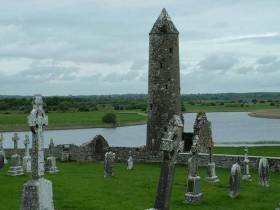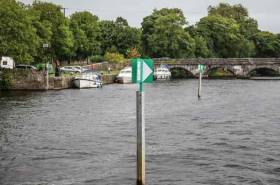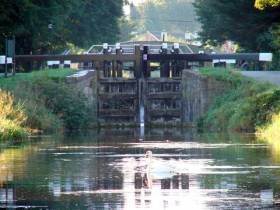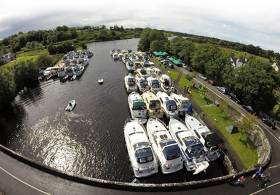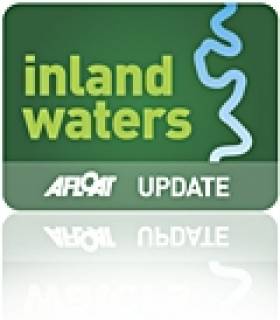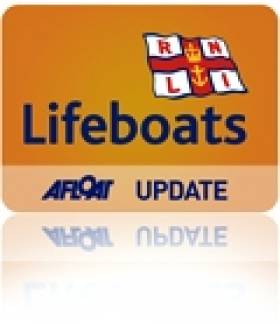Displaying items by tag: Inland Waterways Association of Ireland
Inland Waterways Association of Ireland Will Open New Headquarters on Lough Ree This Week
June 25th 2022 will be an historic day for the Inland Waterways Association of Ireland (IWAI) with the official opening of its new Headquarters at Dunrovin, on the shores of Lough Ree, Coosan Point, Athlone.
IWAI HQ Dunrovin as the building will be known is co-located with the new RNLI permanent Lifeboat Station, recently commissioned. For the last six years, IWAI has worked with RNLI to deliver a strategic partnership project with the RNLI resulting in a permanent Lifeboat Station and an IWAI building on the site where IWAI was born in 1954.
Dunrovin is steeped in waterways history, being the spiritual home of IWAI. In 1997 Cynthia Rice, widow of Colonel Harry Rice and lifelong member of IWAI bequeathed Dunrovin the property and site to IWAI Athlone and the Association. As part of her Will, Cynthia’s bequest stated that the property should be “used in perpetuity as a clubhouse and meeting house for members”. Cynthia’s Will also mentioned the RNLI as an organisation close to her heart. She spent many years fundraising for the RNLI annually with her husband’s niece and close friend Rosemary Furlong, another lifelong member of the IWAI.
Dunrovin, was the summer house of Harry Rice and his first wife Beatrice Geoghegan, (fondly known as Peggy) and his daughter Betty (born 1924). Beatrice died in 1951. Two years later in 1953 Harry married Cynthia, his daughter’s best friend and for many years they lived in Dunrovin. It was here that Vincent and Ruth Delany and Harry and Cynthia Rice devised and hatched plans and a way forward in setting up the Inland Waterways Association of Ireland, now almost 70 years old.
While Harry died in 1964, the property was used by his wife until her death in 1997. To safeguard the property over the intervening years, it was rented out to various tenants. The site was and is frequently used by several water-based sports clubs with the Athlone Boat Club holding their annual regatta at Dunrovin as their base. Athletes practicing for the Triathlon use the waterways directly in front of Dunrovin for their open water swim. IWAI Athlone held many branch meetings in the original dwelling that was the home of the Rice’s. Many active and committed members of IWAI Athlone gave their time and energy ensuring the property did not fall into disrepair and disuse. Over the years, it has remained a primary goal of the Association to honour and carry out Cynthia’s wishes. Now, twenty-five years later, the Association has fulfilled her wishes and has done justice to her very generous bequest and honouring Athlone’s, the Shannon’s, and Ireland’s inland waterways heritage.
The Inland Waterways Association of Ireland (IWAI) is a voluntary body representing over 3,500 enthusiasts, with 25 branches across the island of Ireland.
For the first time a St Patrick’s Day Parade has picked the Inland Waterways as the Parade theme. The IWAI has congratulated the Tullamore Parade Committee on their choice.
By selecting this theme the Parade will highlight the importance of Offaly’s Inland Waterways to the communities through which they flow. In addition to showcasing a variety of water-based activity, the Parade theme will also encourage participants to display their interpretation of the history of these Waterways. Secretary of the Parade Committee Sean O'Brien captures this feeling noting that;
“The Grand Canal has been flowing through Offaly for over 200 years and it has had a significant influence on the business, cultural, heritage and leisure life of the County and its Towns. This is a great opportunity to celebrate this impact and this great facility and we hope that many more people will use the facility over the coming years."
The IWAI has been extended a great honour with an invitation to the President John Dolan to act as Grand Marshall for the Parade. The Tullamore Parade is well-established with over 1,500 participants and up to 10,000 onlookers. While the Parade itself starts at 11.30a.m, proceedings get underway at approx. 10:30am. A flotilla will ferry the dignitaries from Bolands Lock House to the Tullamore Dew Heritage Centre. This flotilla will include members of the Tullamore Canoe Club, the Offaly Rowing Club and the IWAI Offaly Branch. Floats in the Parade will feature the IWAI Offaly Big Bolinder Engine and a variety of vessels including a 13 metre four man rowing boat, a speed boat and a powerboat.
County Offaly is a haven for Inland Waterways and includes lakes, rivers & canals. The Grand Canal, stretching from near Edenderry to Shannon Harbour, winds its way timelessly through the countryside. On reaching Shannon Harbour, one enters onto the mighty River Shannon whose waters form the natural border between Galway & Offaly. From above Meelick in the south of the County towards Athlone in the North, Offaly’s Shannon Waterways boast many treasures including the religious, cultural & historically significant site of Clonmacnoise
Water Abstraction Will Affect Entire Shannon Navigation – IWAI
The Inland Waterways Association of Ireland (IWAI) has responded to Irish Water’s third Public Consultation on the Preferred Option to abstract water from Parteen Basin to service the East and Midlands region.
In its submission IWAI has again expressed grave concerns over the impact that this abstraction will have, not just on Lough Derg, but on the entire Shannon Navigation.
In an effort to mitigate this risk, IWAI puts forward the view that water levels should be monitored and controlled by a single authority, that weirs on the River Shannon should be automated and that flow levels at weirs should be collated and presented by way of a public web portal.
The full IWAI submission, compiled by Association Past Presidents Gregory Whelan and Carmel Meegan, is attached below.
Naas Grand Canal Festival This Bank Holiday Weekend
The inland waterways of Co Kildare comes to life this coming October Bank Holiday weekend. Inland Waterways Association of Ireland (IWAI) Kildare will host it’s now annual Naas Canal Festival from Friday October 28th to Monday 31st. A large fleet of boats is expected to assemble in Sallins harbour on Friday followed by a parade along the Grand Canal, up through the flight of five locks into Naas harbour.
The parade will leave Sallins at 11am and all boats should be in Naas harbour by 5pm. In the spirit of the founders of the IWAI, who established the Association in 1954 to campaign against the installation of fixed span bridges across the River Shannon, IWAI Kildare will use the Naas Canal Festival to showcase the leisure potential of the Grand Canal in this area.
Whether your passion involves travelling through locks by boat, paddling a canoe, walking or cycling for health, well being and enjoyment or waiting patiently for a bite on your fishing line, IWAI Kildare invites you to immerse yourself in the amazing engineering achievement that is the Grand Canal.
IWAI Kildare was established in 1984. In the early years IWAI Kildare was assisted by IWAI Dublin to restore and enable the re opening to navigation of the Naas branch of the Grand Canal main line.
Currently, IWAI Kildare aims to promote the use of the waterways of Co. Kildare by running rallies all over the county.
IWAI Kildare is actively campaigning to re open the Corbally branch of the Grand Canal from Naas harbour to Corbally harbour. This stretch of waterway is in good condition but passage for boats is blocked by a number of culverted crossings, including the road from Naas to Newhall which crosses the canal near Jigginstown.
56th Shannon Boat Rally Visits Athlone
Organised jointly by the Athlone Branch and the Carrick Branch of the Inland Waterways Association of Ireland (IWAI), the Shannon Boat Rally (1961- 2016) is the most prestigious and well-attended boating event on Ireland’s inland waterways. “The families boating on the river love coming to Lough Ree and Athlone as part of the Shannon Boat Rally, said Commodore Keith Rowe, “We look forward to welcoming our boating friends both old and new to join us on Saturday 24th July for ten days and enjoy what the river Shannon has to offer. The Shannon is a wonderful resource being important to leisure and recreation, to heritage, to tourism and to the environment.”
“We know only too well how the river Shannon can bring flooding to our town but on this occasion we are celebrating a more positive side to our waterways. In Portrun this year we are launching a book by Donal Boland focusing on the secret and hidden beauty spots on the Shannon”, explained Mr Rowe. “We are also working closely with the RNLI”, he continued, “and this year we are focusing on taking a more proactive approach to boating safety.
“The main objective of the Shannon Boat Rally”, outlined the Commodore, Mr. Rowe “is to bring boaters of all types together to participate in a ten day long fun event for families and friends on the river. “ “The first rally, explained Mr Rowe, was launched at a civic reception in the Royal Hoey Hotel Athlone in 1961 with over 71 boats participating. Throughout its 56 year history over two-thousand nine hundred boats and over eleven thousand people have participated in the boat rally on the Shannon. This year we expect to attract just under 70 boats and three hundred people”, said Mr Rowe
“The Shannon, explained Mr. John Dolan the Association’s 18th President, from IWAI Offaly, “is a wonderful natural resource with a very significant positive impact for Athlone, and if managed can be a catalyst for urban and rural regeneration.”
The 56th Shannon Boat Rally is an annual event that attracts private boat owners and their families to the Shannon for their annual holidays, contributing to the local economy for the past 56 years. From its origins, the rally has grown in popularity every year attracting all classes of boats crewed by over three hundred adults, teenagers and children who participate in sports, games, sailing and boating competitions, quizzes, talent and music events while improving their boating skills and safety practices on our waterways. The rally brings boaters of all abilities and experiences together to share in a common purpose to enjoy the waterways, to share boating know-how and improve their boating skills. The boat rally has attracted many boaters to our inland waterways and promoted development of facilities along the navigation as well as bringing a great dynamic and valuable business to the towns and villages along the river and lakes. The boat rally also encourages responsible use of the waterways for the benefit of all waterway users and has a strong educational, environmental and boating safety theme.
At the recent AGM in Tullamore of the Inland Waterways Association of Ireland (IWAI) Mr. John Dolan was elected as the Association’s 18th President, taking over the helm from Ms Carmel Meegan.
John has been very active on our inland waterways over a great many years both at Executive and branch level. John has served as IWAI Vice President since 2014 and has previously held the role of Liaison & Lobbying Officer and PRO on the IWAI Executive.
At local level John is a member of IWAI Offaly where he has fulfilled numerous roles including Chairperson and Vice Chairperson. John has been instrumental in highlighting the potential of the Grand Canal for tourism development in recent years. This has resulted in the development of Tullamore as a focal point for major festivals including Fleadh Cheoil na hÉireann and the Johnny Keenan Banjo Festival.
John has also worked tirelessly with the local political and business community in Offaly to promote events including Discover the Grand Canal Cruise in Company and the Grand Canal Offaly Floating Festival or Grand COFF.
On a national level, John has played a key role on the IWAI Canals Action Group. This subcommittee has liaised with IWAI members, canal communities, local businesses along the canals corridor and local and national politicians to ensure that Bye law changes proposed by Waterways Ireland for the Grand Canal, Royal Canal & River Barrow Navigation put user requirements, tourism development and local communities at the centre of the regulations.
In his address as incoming President John Dolan thanked the outgoing President and the IWAI Executive for all of their work in recent years. In looking forward to his own term of office, Mr Dolan cited several opportunities where IWAI can influence the governance and development of our Inland Waterways including Canal Bye-laws & Water Abstraction. He also noted that IWAI as an Association can develop over the next few years the preservation of the IWAI’s past for the future, attract future generations to become IWAI members & broaden the IWAI ethos and message to new audiences.
Also at the AGM Mr Alan Kelly was elected as IWAI Vice President, succeeding John Dolan in that role. Alan is a native of Dublin and has been an active member of IWAI Kildare since 2003.
Inland Waterways Association of Ireland Canal Bill Election Campaign Gathers Pace
Election Candidates nationwide have being contacting the Inland Waterways Association of Ireland (IWAI) to pledge their support for an IWAI call for provision to be made for new canal bye-laws via a dedicated Canal Bill during the next Dáil, according to the IWAI.
This campaign allows Candidates an opportunity to publically demonstrate their support for the Canals and their Communities and their efforts to encourage the use and growth of the canals with legislation that is centred on the communities, users and tourism.
The pledge to date is receiving good cross party support. The IWAI web team will be updating local and national media next week on candidates supporting the pledge.
The pledge:
"IWAI request election candidates to pledge their support for an IWAI call for provision to be made for new canal bye-laws via a dedicated Canal Bill during the next Dáil when possible rather than including any future legislation in a joint Bill such as the Heritage bill 2016. Furthermore in developing The Canal (Amendment) Bill 2017 that recognition be given to the canal users, canal communities and Local Authorities adjoining the canals by way of prelegislative
consultation and scrutiny. This approach would be in line with Government reform and best practice."
Background
With no advance notice or consultation with the inland waterways stakeholders & canal communities the Heritage Bill 2016 was published on 4 January 2016.
IWAI advised that while it would welcome and support proper regulations the proposed Bill did not put user requirements, local communities or tourism at the centre of the regulations. Rather the now lapsed bill is a heavy handed approach that will result in lower boat traffic on the canals.
Prior to the 2016 Bill, in January 2014 Waterways Ireland brought forward proposals for amendments to the Canal Byelaws 1988 under the Canals Act 1986 & Maritime Safety Act 2005. IWAI campaigned vigorously during the minimal consultation period of 21 days. Public discussion in 2014 on the matter included - the Canals and Barrow as a tourism resource; queries raised in the Seanad and the Dail; County Councils input; public meetings; national and local press articles; television and radio interviews; community websites; blogs and facebook pages. These all reflected the reservations of users, communities and public representatives as to the significant impact of the draconian suggestions in the proposed bye-laws.
The IWAI campaign resulted in an invite to appear before the Oireachtas Joint Committee on Environment, Culture and the Gaeltacht.
Feedback from members of this cross party Committee who met on 25 March 2014 included:
• “I am fearful that proposals will be implemented without further recommendations” - Senator Cait Keane. Fine Gael Labour Panel.
• “I am of the view that Waterways Ireland must return to the beginning and reconsider this matter from a very practical viewpoint. What is proposed is going to lead to the closure of the Canal” - Deputy James Bannon. Fine Gael Longford - Westmeath
• “People should not feel pushed out of an activity they have grown up with, love and wish to pass on to other generations and the community to help local economies with the tourism income it can provide” -
Deputy Barry Cowen. Fianna Fail Laois - Offaly
• “The Bye-laws will impact heavily on a small number of people” - Deputy Catherine Murphy. Independent Kildare North
• “The huge increase in some fees is unacceptable and there is serious concern that the proposed fees will
damage tourism and drive people from the waterways” Deputy Sandra McLellan. Sinn Fein Cork East
• “The new bye-laws will make exacting demands on users of the Canal” - Deputy Seamus Kirk. Fianna Fail. Louth
• “The five day rule, which I believe is completely unworkable” - Deputy Ann Phelan. Labour Carlow Kilkenny
The 2014 proposed byelaws if passed would not have had any validity as noted this year on the Waterways Ireland website “The Minister was subsequently advised by the Office of the Attorney General that amendments to the primary legislation governing the bye-laws (the Canals Act 1986) would be necessary to ensure that the new bye-laws would not be ultra vires.” The proposed invalid bye-laws were published with no prior consultation and a short public consultation period of just 21 days, resulted in over 2300 submissions on the issue.
The current position
Two years later and it seems no lessons have been learned on how to communicate with the customer and communities along the canals.
The powers proposed within the new Act will affect those on the waterways of Carlow, Dublin, Kildare, Kilkenny, Laois, Longford, Meath, Offaly and Westmeath. The bill had Stage 2 approval in the Seanad, but is now lapsed due to the dissolution of the Dáil this month.
Future Outlook
Politically, this is now a very big issue. It is going to feature highly as candidates face into elections this spring. The IWAI have gained the interest of local, regional and national politicians on this matter to date, who on behalf of their constituents, want to develop, not constrict, canal use.
Future of Graving Docks in Limbo as Plot 8 is Transferred to NAMA
#INLAND WATERWAYS - The site of the former graving docks at Grand Canal Dock has been transferred to NAMA in a deal which frees the Dublin Docklands Development Authority (DDDA) from a €29 million plus bank guarantee.
Plot 8 at Sir John Rogerson's Quay is one of a suite of nine sites that have been transferred to the Government's 'bad bank' in a negotiated loan settlement that extricates the Docklands body from loan guarantees given by banks that financed the "disastrous" Dublin Glass Bottle site deal in 2006.
Sites handed over in the deal include the former 'U2 Tower' and the historic BJ Marine premises on the banks of the Liffey, as well as the aforementioned Dublin Glass Bottle site.
The Dublin branch of the Inland Waterways Association of Ireland (IWAI) had been hoping to embark on a restoration of the graving docks at Plot 8 to their former working order (a detailed history of the docks and restoration plans is available HERE).
This project had been given the blessing of the DDDA and Waterways Ireland, which owns the freehold lease on the site, with a view to its restoration helping to fund the Ulster Canal scheme.
However with the transfer of the DDDA's interest in the site to NAMA, the authority has now withdrawn permission for the IWAI to do any restoration work, leaving the future of the graving docks in limbo.
Green Light for Lough Ree Lifeboat
Formal representations were made to the RNLI by the Inland Waterways Association of Ireland with support from lough users and various statutory bodies including the Irish Coast Guard, for a declared search and rescue asset to be present on the Lough.
The charity already operates 43 lifeboat stations around the coast of Ireland and inland on Lough Derg and Lough Erne with around 1,500 volunteer lifeboat crew members. There are estimates of upwards of 1,000 boats moored in or around the Lough, which also has a number of large marinas. The Lough is also a major intersection on the Shannon-Erne navigation route.
The RNLI will initially operate a B class Atlantic 75 lifeboat from temporary station facilities. The lifeboat will come from the existing RNLI relief fleet and a decision will be taken following the year-long trial whether to establish a permanent station.
Martyn Smith, RNLI Divisional Inspector for Ireland, said: 'I am delighted that the RNLI Trustees have agreed to place a lifeboat on Lough Ree. The support and enthusiasm for an RNLI lifeboat on Lough Ree from the Inland Waterways Association of Ireland, lough users and statutory agencies has been enormous. As a charity which relies on volunteers and the generosity of the public we were very impressed with the level of interest and engagement from everyone we encountered.'
Lough Ree is at present the only major lake on the Shannon that lacks a dedicated search and rescue presence. It is the centre for a variety of leisure pursuits based both afloat and ashore and has a significant amount of marine traffic passing through. It therefore makes sense for the RNLI to have a presence here which will see us take local volunteers, train them to the highest standards, provide them with the best equipment and enable them to deliver a life-saving service that Lough Ree needs.'
Initial meetings have already been held by the RNLI locally to gauge interest and support and moves will now be made to recruit the volunteers needed to run the lifeboat station.
View Larger Map
Largest Vessel Transits Samuel Beckett Swing-Bridge
She remained alongside this berth which is normally used by large commercial ships until the vessel sought a berth much closer to the city-centre. This led to a shift of berths in the evening when the 2003 built vessel headed upriver to the Dublin City Moorings facility at Custom House Quay, but this firstly required transiting through two bridges.
With a beam of 10.6m Fortunate Sun entered through the East-Link toll-lift bridge followed by the Samuel Beckett bridge, the Liffey's newest crossing point which opened in late 2009. The €60m bridge was commissioned by Dublin City Council and designed by the Spanish architect engineer Santiago Calatrava. To read more on the bridge click HERE.
Fortunate Sun is registered in the Caymen Islands and is capable of over 17 knots on a range of 5000 nautical miles. She has a steel hull and an aluminium superstructure and interiors also by Tim Heywood Design. In the early hours of tomorrow morning the vessel built by Oceanfast is to depart through the 5,700 tonnes bridge which was delivered by barge after a five-day voyage from Rotterdam.
There has been previous transits of the bridge notably the annual Dublin Rally organised by the the Inland Waterways Association of Ireland (IWAI). This year's Dublin Rally took place on 1 May when boats travelling on the Royal Canal descended via Croke Park and entered the Liffey at Spencer Dock. This required the Iarnrod Éireann bridge-lift and the water level in Spencer Dock to be lowered so to allow safe clearance under the Sheriff St. bridge.
From there the IWAI flotilla made the short passage downriver to re-enter another inland waterway system at the Grand Canal Dock, marking where the Liffey connects with the city's southern canal. The 2011 Dublin Rally was the first time since 1955 that boats could enter Dublin from the Shannon via the Royal Canal and the first time since 2004 that boats also joined from the Royal Canal.
- powerboats
- motorboats
- inland waterways
- Dublin Port
- Dublin
- Grand Canal
- IWAI
- Royal Canal
- DDDA
- Inland Waterways Association of Ireland
- Dublin City Council
- Spencer Dock
- River Liffey
- Ports and Shipping News
- EastLink Toll Bridge
- Dublin Port news
- Grand Canal Dock
- Dublin Docklands Development Authority
- M.Y. Fortunate Sun
- Tim Heywood Design
- Lifffey
- Dublin City Moorings
- Custom House Dock
- Powerboat news
- Motoryachts
- Sir John Rogerson Quay
- Inland Waterways news
- Dublin Rally
- Ianrod Eireann
- Oceanfast
- Scottish Western Isles





























